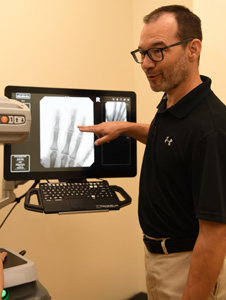Wrist Arthroscopy
![]() Arthroscopy is a minimally invasive technique of visualizing the inside of a joint. Wrist arthroscopy allows the surgeon to diagnose and treat many problems of the wrist through a series of very small incisions. Because the incisions used with wrist arthroscopy are smaller and disrupt less soft tissue than conventional open surgery, pain, swelling and stiffness are minimized and recovery is often faster.
Arthroscopy is a minimally invasive technique of visualizing the inside of a joint. Wrist arthroscopy allows the surgeon to diagnose and treat many problems of the wrist through a series of very small incisions. Because the incisions used with wrist arthroscopy are smaller and disrupt less soft tissue than conventional open surgery, pain, swelling and stiffness are minimized and recovery is often faster.
This minimally invasive procedure allows your Celebration Orthopaedics hand surgeon to evaluate and treat injuries and disorders of the ligaments, cartilage and bones of the wrist. After an injury, pain, clicks, and swelling may indicate an internal problem in the wrist. When wrist problems are encountered, many are treated through these small incisions using specialized instruments available for wrist arthroscopy. Often arthroscopy is used to aid in the reduction of fractures of the bones of the wrist.
 The procedure is performed under general, regional, or local anesthesia. A small camera fixed to the end of a narrow fiber optic tube is inserted through a small incision in the skin directly into the back of the wrist joint. The camera lens magnifies and projects the small structures in the wrist onto a video monitor, allowing for more accurate diagnosis. The wrist is often distracted and filled with fluid to expand the joint and allow improved visualization during the procedure.
The procedure is performed under general, regional, or local anesthesia. A small camera fixed to the end of a narrow fiber optic tube is inserted through a small incision in the skin directly into the back of the wrist joint. The camera lens magnifies and projects the small structures in the wrist onto a video monitor, allowing for more accurate diagnosis. The wrist is often distracted and filled with fluid to expand the joint and allow improved visualization during the procedure.
Once the wrist has been diagnosed, your Celebration Orthopaedics hand surgeon may use one ore more of the arthroscopic instruments to treat any damage. Damaged cartlige may be removed, ligament tears may be repaired or debrided, and bone may be shortened.
After your arthroscopy, you will most likely be placed into a wrist splint that allows full mobility of your fingers. The period of immobilization will vary depending on what was performed at the time of surgery. Elevating the involved extremity is important to prevent excessive swelling and pain after your surgery.

 Arm & Hand
Arm & Hand